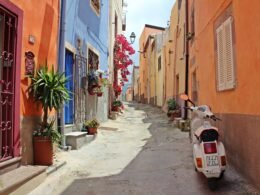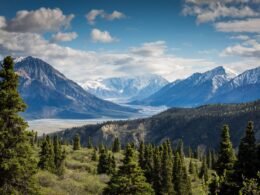The famous Pulpit Rock, or Preikestolen in Norwegian, is a steep cliff made of solid rock that juts out over the breath-taking Lysefjord, some 600 metres below. It’s located in Strand, Rogaland, central Norway, which is south-west of Oslo.
Many visitors to Pulpit Rock, base themselves in Stavanger for a few days beforehand, which is the nearest city. Pulpit Rock is famous for its spectacular views of the surrounding landscape in the Ryfylke area, blending together sublimity and beauty.
The cliff edge is almost vertical while the top is a kind of plateau, which makes it the perfect place for a photo opportunity. Pulpit Rock is one of the most popular tourist destinations in Norway, and the country’s most popular hike, with hundreds of thousands of visitors annually.
There are several options when it comes to hiking routes, in this guide we’ll go through what you’ll need, the best route to take and what to consider when visiting this gem.

Before The Hike
Staying for at least a few days in Stavanger beforehand is probably a good idea. There are inexpensive flights to Stavanger from numerous cities in Europe, including from London, Paris, Copenhagen and Berlin.
Stavanger is the third largest city in Norway and there are plenty of places to stay, including hostels and hotels, as well as lots of cafes and restaurants. Be sure to have all of the hiking equipment you need beforehand, considering the country’s Nordic climate.
Essential kit includes sturdy walking boots, warm and waterproof clothing, plenty of food and drink, a GPS-enabled device, and of course, a camera. Bear in mind that the equipment you need will also depend on the season. The hike itself isn’t especially demanding, so you won’t need any specialized equipment unless you’re visiting in the mid-winter.

Basecamp, Route & Terrain
There are a few different routes to Pulpit Rock, though there is one route that is the most common. A lot of hikers start from Preikestolen Fjellstue (Preikestolen Basecamp), which is a lodge just east of the town of Jørpeland. It offers comfortable cabins and hot showers and is located in the hills of the Ryfylke region, close to Refsvatn lake.
If you’re driving from Stavanger, bear in mind that there is a toll for the road tunnel and there is a car park at the lodge. Guest can also swim and fish in the lake, and there are kayaks and canoes for rental.
There are also a few campsites enroute to the basecamp lodge once you have passed through Jørpeland, if you prefer to camp instead. We recommend staying the night before the hike at the basecamp lodge, which can be reached from Stavanger via bus, taxi or car.
There is also public bus that runs from Sandnes and Stavanger directly to the basecamp lodge (tickets should be purchased online beforehand).

In recent years, the main path to Pulpit Rock has been made more accessible by Nepalese sherpas, so you know that you’re in good hands. If you’re following the main route, hiking from the basecamp lodge totals almost five miles as a round trip.
For adults of moderate fitness, it should take around four hours walking time, discounting time for breaks and the time spent at Pulpit’s Rock. Plan for a longer trip if you are accompanying children or the elderly.
The hike itself can be quite challenging in parts because of the ascent and the rocky terrain, but as long as you are moderately fit and well, the hike should be an enjoyable experience.
There will be plenty of opportunities to rest and even to swim along the route but bear in mind that there aren’t any toilets enroute or places to buy food or water.

When To Visit Pulpit Rock
We recommend visiting in the summer months, but the winter can also be fun if you have the right equipment. Pulpit Rock is accessible throughout the year, but the hiking season generally runs from May to October.
If you’re visiting in winter, be sure to pack warm clothing and be ready for some snow with the right equipment, which could include crampons, pickaxes and walking poles.
Be sure to check the weather conditions before starting your journey, which should be available from the base camp lodge.
There are also guided hiking tours to Pulpit Rock, though they typically only operate from May to September. At 604 metres above sea level, Pulpit Rock can get windy, and expect it to be a bit colder than it is at basecamp. Pulpit Rock can also get busy in the heart of the summer but bear in mind that Norway is still a sparsely populated country, so huge queues and crowds will be rare.
In the winter months, expect average temperatures to be around -1 degrees Celsius, while autumn is the rainiest season. In the peak summer months, July and August, the average temperature is around 18 degrees.

After The Hike
What better way to relax after a day’s hike than taking a dip in Refsvatn lake, or alternatively in Lysefjord? In the summer months, this is an ideal option. Visitors to the area can also enjoy a cruise on the fjord, or if you’re spending a few days in the region, there are plenty of other hikes available, as well as outdoor activities such as kayaking, fishing, camping and mountaineering.
After coming back down to Earth, why not take the bus back into Stavanger to enjoy the cultural and culinary amenities of the city?
All in all, Pulpit Rock is one of the best loved tourist attractions in all of Norway, and it’s easy to see why thanks to the natural beauty of its surroundings and the uniqueness of the landscape.














